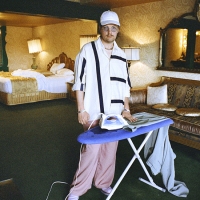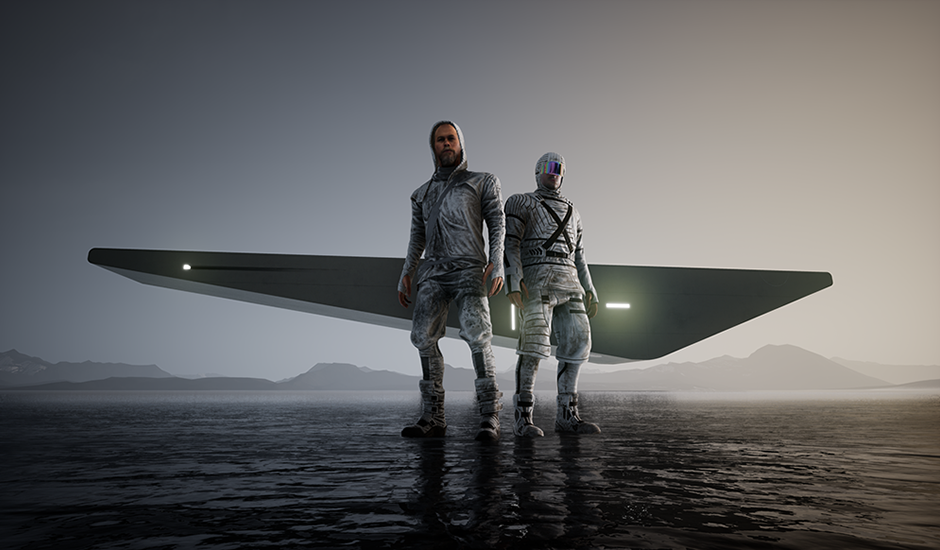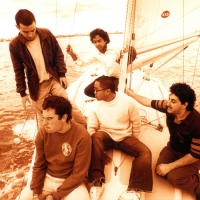 After a decade of shaping dance music, Myd’s time has arrivedMyd has an ever-lasting imprint in French electro, from Club Cheval to Ed Banger. Now, it’s his own time for the spotlight.
After a decade of shaping dance music, Myd’s time has arrivedMyd has an ever-lasting imprint in French electro, from Club Cheval to Ed Banger. Now, it’s his own time for the spotlight.

The futurism of H3000: Luke Steele and Jarrad Rogers' new project
H3000 brings together two of Australia’s most forward-thinking musicians for an emotive intergalactic journey.
Finding common ground between Luke Steele and Jarrad Rogers isn’t a particularly difficult task. Each of their respective work thrives with creative experimentalism, and it’s best shown through collaborative work, much of it being amongst the country’s most well-recognised.
Take Steele, for example, and his decades-worth of artistic brilliance from fronting The Sleepy Jackson and Empire of the Sun to projects like DREAMS, all amongst irregular solo work of his own. Then, there’s Rogers: A heavyweight behind-the-scenes, with collaborations spread both internationally (Lana Del Rey, Charli XCX) and locally (Delta Goodrem, 5SOS), all without counting those he works alongside on his newly-minted Noize Recordings venture.
It should be no surprise that the two eventually found one another, especially considering that for a while, they were both Australian ex-pats living in Los Angeles. “I was working with Daniel Johns in Los Angeles and we needed help with a couple of tracks, and the Australian producer M-Phazes came down and brought Jarrad along with him,” says Steele, talking from his Californian home. The two clicked over Jarrad’s “crazy production” and sampling; how Jarrad could build something out of just the pens and notepads lying around in the studio. “I just didn’t care to open my sample library that day,” Rogers explains.
H3000 didn’t begin straight after this studio encounter. The sessions with Daniel Johns eventually became DREAMS, an entirely different project for Luke Steele that would wind up putting out an album - No One Defeats Us - back in 2018, with Rogers credited on four of its tracks. Soon after, however, Jarrad - known under his production alias MSTR ROGERS - sent over a couple of ideas to Steele with no real intention, and what Steele did with them triggered the spark for H3000. “I remember it came through the phone so clearly and it was just so incredible. Then, came another, and another.”
It was an incredibly quick process from there; a rough idea from Rogers soon ballooning out into an entire song, then multiple songs, and now an entire album - scheduled for release on September 17th. “We were on a similar wavelength to one another, and it was all super fast,” says Steele. A fraction of the album was written when they were both living in Los Angeles, but when Rogers moved back to Melbourne before the pandemic hit, the speed of H3000 didn’t slow. “I’ll send a vocal early in the day, and then by dinner, Rogers has built a new section or a new track,” says Steele. “I think when you have kids and stuff, you work at a pace which is like hyperspeed, trying to fit it all in.”
As a project, H3000 is as much about transporting you to a distant future - the year 3000, as the name suggests - as much as it is considering the trials and tribulations people will face in the year 3000. There are reflections on loss and love, feelings of uneasy anxiety mixed with a dash of hope, and questions about life and sustainability all packaged within the confines of the self-titled album. “What are the issues going to be in Year 3000?” Steele asks. “Maybe the world has worked out how to get rid of wars? Maybe there are passports that show what you think about? What’s the world going to be like in 3000?”
H3000 - the album - doesn’t set out to answer those questions per se, but it’s full of the introspection and self-evaluation that comes with conceptualising the future. July Heat, the first single previewed from the duo, sees Steele ask big questions - “Why am I always needing a break when I'm meant to be free? What does that say?” - while the album’s second taste, the newly-minted Running, encapsulates the heart of the greater project, dissecting the loss of a close friend and the strength that builds in the face of tragedy. It’s something everyone will have to face, in both their near and far futures.
“Any time something tries to corrupt you or devalue you…” Steele begins to explain. “If you can break through that, you get closer to God; God gives you tests and if you don’t pass that test then you just keep getting given that test.” It’s a cycle that Steele has experienced in the past, and one that will no doubt emerge in his future as well. “You have to realise that’s the forces of the dark world trying to corrupt you, so you have to push past that. Once you do, there’s liberation and freedom.”
H3000 attempts to make sense of it all, of the corruption that distorts the mind and people in the current day, as well as both in the past and future. Rest, a yet-to-be-released song from the album, reflects on an experience both Jarrad and Luke shared: the passing of Avicii in 2018. “I was going to work with him and Jarrad already worked with him and it was an experience that affected us both,” Steele reflects. “There’s a real corruption of the mind and the heart for something like that to happen.”

Navigating the discographies of both Luke Steele and Jarrad Rogers, one thing that becomes quickly apparent is how they’ve never shied away from embracing futurism and forward-thinking experimentalism. Empire of the Sun, for example, often have universe-spanning visions tied into their album releases, with an artistic and creative depth years beyond any other artist they’re sharing a release date with. For Rogers, meanwhile, you can hear the creativity thrive in everything he does; as a songwriter and producer bringing out the peaks of the artists he works alongside, and as a record label founder with a knack for discovering new artists, and making them feel like nothing else we’ve ever heard before.
It should mean something then, to say that H3000 is perhaps the most adventurous the pair have ever been with their work. Musically, both July Heat and Running are almost indescribable in their sound. The productions are part-metallic-sounding, but also liquid-y and free-flowing, and Luke Steele’s vocals simultaneously captures the soaring freedom and euphoria of free-thinking but also the claustrophobia and mania of looking so far forwards. “I think we just get led by the process,” says Rogers, asked about the album’s productions. “If it feels right and inspires Luke then amazing, we’re going to keep following those sounds.”
Then, there are the album’s visuals, which add a further dimension to the vision H3000 aims to communicate. Collaboratively built alongside production and design studio Collide, the visuals were painstakingly built in the gaming software Unreal Engine - the same software that hosts Fortnite, Gears of War, Final Fantasy and others - in order to deepen the project’s otherworldly edge. There’s also a playable game too, allowing fans to virtually step into the H3000 world and embrace the futurism Steele and Rogers aim to communicate with the project.
“It’s something that really developed over time,” says Steele, asked with how the H3000 experience ballooned from a stand-alone album to an entire immersable universe. “We were right into things being alien-like and futuristic, but it wasn’t until Collide came on… They built this entire world. They saw the vision and I guess painted in the bits that were blank and it all fitted together.”

As an entire project, H3000 is amongst the most complex and intricate I’ve come across, in its sound and greater immersive vision right down to its embrace of the future, and the inquisitive questioning that forward-thinking projects often lack. H3000 isn’t afraid to tackle the claustrophobia or anxiety that the future may hold; it instead reaches forward and attempts to make sense of it all, and the thinking and actions that underpin the overarching themes the album includes.
In the present, however - a mere 979 years prior to H3000 becomes a reality - there is still plenty to take away from Steele and Rogers’ vision of the future, and plenty they’ve learnt from it themselves. There are lessons about resilience and growth amongst reflections on personal corruption and well-being; things that affect the future of yourself and everyone around you. There’s an almost-Butterfly Effect-like ring to the album: What is the future going to be like, and working backwards, how do I deal with or alter that?
It’s an album that came with a lot of learnings for both Luke and Jarrad too, despite the decades worth of experience between them. Steele, for example, takes note of inspiration, and the creative power that can blossom when it’s not forced unnaturally. Rogers, meanwhile, muses how collaboration encourages growth, tapping into the same vein of thinking that H3000 relishes in. “When people come together to create, you learn a lot from each other…,” he ponders. It isn’t all just about music either, you’ve got to learn about being better humans too.”
Perhaps by the year 3000, we will have worked out how to be the best humans we can be. That sounds like a question H3000 would set out to answer.
H3000's self-titled debut album will be released on September 17th via EMI Music Australia. Pre-order it now.
 After a decade of shaping dance music, Myd’s time has arrivedMyd has an ever-lasting imprint in French electro, from Club Cheval to Ed Banger. Now, it’s his own time for the spotlight.
After a decade of shaping dance music, Myd’s time has arrivedMyd has an ever-lasting imprint in French electro, from Club Cheval to Ed Banger. Now, it’s his own time for the spotlight.
 Celebrating 20 years of Since I Left You with The AvalanchesAs they celebrate 20 years of their infamous debut album with rarities and remixes, we dissect the history of one of Australia’s greatest albums with the band who made it.
Celebrating 20 years of Since I Left You with The AvalanchesAs they celebrate 20 years of their infamous debut album with rarities and remixes, we dissect the history of one of Australia’s greatest albums with the band who made it.